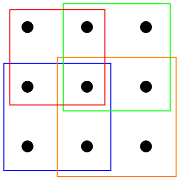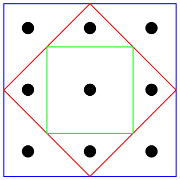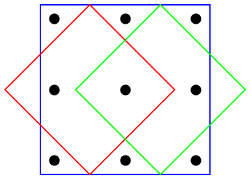Another Nine-Dots Puzzle
I recently wrote an essay, Thinking Inside and Outside the Box, which starts with a famous nine-dots puzzle that kicked off the expression: thinking outside the box. Here is another puzzle with the same nine-dots setup.
Puzzle. What is the smallest number of squares needed to ensure that each dot is in its own region?

Usually, people who try to solve this puzzle come up with the following four-squares solution.

As with the classic nine-dots puzzle, they imagine that the dots are on a grid and try to build squares with sides parallel to the grid lines. What would be the outside-the-box idea? The sides of the squares would not need to be parallel to the grid. This way, we can solve the puzzle with three squares.

One of my MathRoots students offered a different and awesome solution also using three squares.

Share:
JBL:
Is it clear that 2 is impossible? (The most naive thing doesn’t work: you get 10 regions if you take two squares of the same size and same center that are rotated 45 degrees.)
[Sorry if this comes through multiple times.]
5 August 2022, 9:08 pmAlex:
is this a strictly 2D problem, with squares always in the same plane as the dots?
5 August 2022, 10:58 pmif squares are allowed to be “square” on some other planes and projected on this one, other solutions might be possible
Ivan:
By “thinking outside the box” those two solutions might be generalized:
7 August 2022, 3:27 amSolution 1: The edges of the red square might intersect the edges of the blue one.
Solution 2: Three edges of the blue square might be intersected by the edges of the red and green squares.
rosie:
It doesn’t surprise me that some people come up with your first solution attempt. Your statement of the problem did not make it clear what exactly is or is not allowed as a “square”, nor yet what you mean by “region”.
Thinking outside the box is all very well, but the problem statement should be clear and unambiguous in every aspect.
8 August 2022, 8:30 amMath Book:
I’m not surprised that some folks come up with your initial effort as a solution. You did not explicitly define what is or is not permitted as a “square” or what you mean by “region” in your presentation of the issue.
14 August 2022, 1:13 amJBL:
This comment is just to point out that the previous comment is an old-style spam-bot
31 August 2022, 10:14 am